|

 Up
Up 
 1900 Van Cleve
1900 Van Cleve 
(You are here.)



  Need
to Need
to
find your
bearings?
Try
these
navigation aids:
If
this is your first
visit, please stop by:
Something
to share?
Please:



|
|
Available in Française, Español, Português, Deutsch, Россию,
中文,
日本, and others.
 he
Wright brothers had been selling and repairing bicycles in Dayton,
Ohio for four years when in 1896 they announced they would begin
manufacturing their own. By this time, they had experience with
hundreds of bicycles and dozens of brands. As repairmen, they knew
what problems they were seeing most often. They were also avid
cyclists or "wheelmen." So they knew
what bicycle brands ̶ and what parts of those brands ̶
were performing best. he
Wright brothers had been selling and repairing bicycles in Dayton,
Ohio for four years when in 1896 they announced they would begin
manufacturing their own. By this time, they had experience with
hundreds of bicycles and dozens of brands. As repairmen, they knew
what problems they were seeing most often. They were also avid
cyclists or "wheelmen." So they knew
what bicycle brands ̶ and what parts of those brands ̶
were performing best.
In those days, most brands of bicycles were made by "boutique" manufacturers. These
small shops
rarely manufactured anything from raw materials; they simply bought
frames, wheels, handlebars, saddles and other parts from
large businesses that specialized in making them, then assembled
bicycles from those parts.
This is what the Wright brothers set out to do, and they drew on
their experience as repairmen and wheelmen to build a better bicycle. They had
learned not just what parts endure, but also how to combine those
parts to create a safe and comfortable ride.
Or, at least, as safe and comfortable as one could make a bicycle in
1896. The safety bicycle had been introduced in 1876 by English
engineer Harry John Lawson, but it didn't catch on until 1885 when
inventor John Kemp Starley produced the "Rover," a bike with
same-size wheels, a chain drive, and direct steering. This English
design became popular in America when the Overman Wheel Company of
Chicopee, Massachusetts began producing them in 1887. But it was
still very much in flux when the Wrights introduced the Van Cleve
nine years later. Some of the components that modern cyclists take
for granted on a bicycle, such as brakes and inner tubes, were still
in the future in 1896.
Nonetheless, the Van Cleve was fairly advanced for its day. The
Wrights adopted the latest version of the "double diamond" frame
with a horizontal crossbar that put the rider almost directly over
the pedal. The frame was tall enough and the telescoping seat post
long enough that the rider could adjust his machine so his legs
would be fully extended and all his weight over the pedals with each
down stroke ̶ this gave him maximum power. The Van Cleve
was a racing machine.
The biggest problem facing American bicycle designers in 1896 was
the poor conditions of America's roads. There were less than twelve
miles of paved road surface in Dayton, Ohio at the turn of the
century, and very few gravel roads. Most city roads were little more
than dirt paths, sometimes "combed" with a horse-drawn grader to
smooth the ruts and sprinkled in dry weather to keep the dust down.
(The Wrights' older brother Lorin had a part-time job as a street
sprinkler.) But even these combed patches rapidly deteriorated. The
challenge was to design a bicycle that would produce the smoothest
possible ride over an uneven, rutted surface.
The first step was to make the wheels big enough to roll over the
bumps. The Van Cleve had 28-inch diameter wheels, the largest that
were commonly available on safety bicycles at that time. Next, the
designer had to somehow absorb the shock and vibration of the rough
ride. This is the reason for the decorative steel plates that join
the arms of the front fork on the Van Cleve. They are actually leaf
springs, meant to reduce the worst of the shocks that reached the
rider from the front wheel. This also explains the wooden
handlebars. Unlike steel, wood flexes slightly without breaking, and
then returns to its former shape without bending. This property of
wood further reduced the shocks that reached the arms and shoulders
of the rider. Finally, the coil springs under the seat dampened
those shocks that would have affected his or her spine.
The poor condition of the roads afflicted the bicycle as well as the
rider. The loose dirt and dust kicked up by the wheels got into
every moving part and ground away at the metal like sandpaper. The
most susceptible were the bearings in the wheel hubs. These parts
had to be lubricated to roll smoothly, but the lubricating oil or
grease mixed with the dirt to create gritty, grinding mess.
Consequently, early bicycle bearings had to be periodically
disassembled, cleaned, and lubricated.
To counter this problem, the Wrights invented a hub sealed with felt
washers. This sealed hub could be filled with oil, creating an
oil reservoir. When the wheel spun, the resulting centripetal force
created a small positive pressure inside the hub forcing the oil
against the felt seals. This kept the dust and dirt from working its
way inside. The Wrights claimed that owners could wait as long as
two years before adding more oil or cleaning the parts. And if for
some reason the oil leaked or dirt got inside, the hub carried its
own spare parts. The outer bearing "races" and the nuts that
captured them were interchangeable. If an outer race ̶
the most likely part of the bearing to wear ̶ became
unusable, all the owner had to do was exchange the position of the
parts.
As advanced as the Van Cleve may have been in 1897, its design was
constantly evolving. The Wright brothers changed and improved
components constantly to keep up with developments in the bicycle
industry. By 1900, the Van Cleve was a very different bicycle from
this early model. The Wrights discarded the tall frame for a shorter
one that was easier to mount. The rear hub was redesigned to include
coaster brakes, allowing the owner to stop simply by back-pedaling.
As Dayton roads improved to accommodate bikes and automobiles, the
wooden handlebars were replaced with steel. And these are just a few
of the changes that were made.
And no matter when the Wright brothers made a bicycle, their
standard Van Cleve design was just a jumping-off point. Wright
advertisements emphasized that customers could pick and choose from
an ever-increasing variety of components. The bicycles that rolled
out of the Wright Cycle Company were customized for each client to
fit their personal preferences and financial needs. Perhaps the only
consistent Van Cleve feature was that each bicycle had been planned and
assembled with the expertise of two inventive and knowledgeable
wheelmen.
|
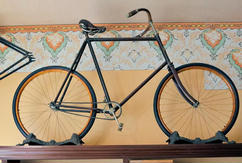
The Van Cleve is commonly displayed in the Wright Cycle Company
building in Greenfield Village. It sits atop a display case in the
retail part of the shop.
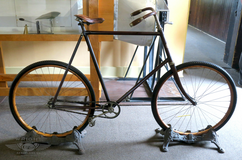
The bike has wood wheel rims with single-tube tires (no inner tube), 28 inches
in diameter including the tires. The large wheels helped to
negotiate the bumps and ruts in the unpaved roads of Dayton just
before the turn of the twentieth century.
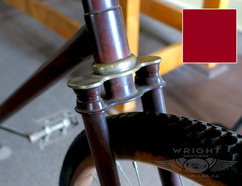
The Wrights offered the Van Cleve painted with the "finest rubber
baking enamel" either black or carmine. This bike was once carmine
-- a deep wine-red as shown in the color swatch. The pigment, an
organic substance extracted from insects, has faded
over the last 120 years.
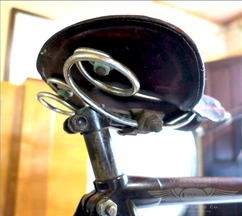
The underside of the seat, showing a two-piece seat post.
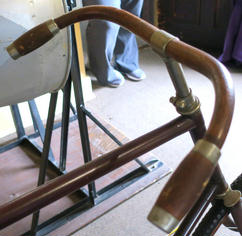
Another view of the handlebars, showing the cork grips.
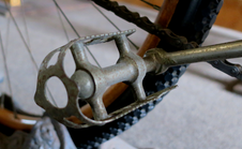
The Wrights were partial to "rat trap" style pedals ̶
these could be easily fitted with toe clips for racing.
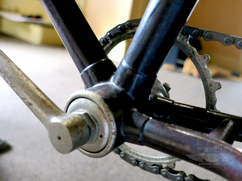
All the frame tubes are reinforced by "sleeve joints" where
they join other tubes, adding strength to the frame.
This detail shows the tubes that join the bottom bracket, where the
crankset was housed.
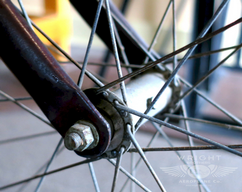
The front hub of the Van Cleve -- note the oil filler cap.
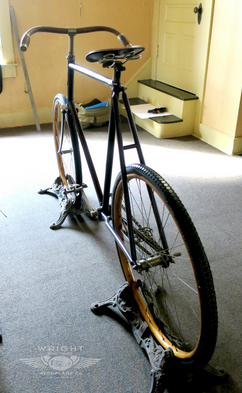
A rear view of the Van Cleve, to better show the seat stays
and chain stays.
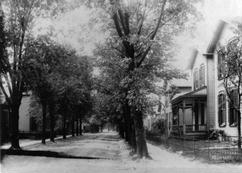
Hawthorne Street in 1895. This is where the Wrights lived in Dayton,
Oho. Note that the street in unpaved; there isn't even any gravel.
The surface is just packed dirt, with a few piles of horse manure
here and there. The Wright house is the one with a porch, second
from the right.
|
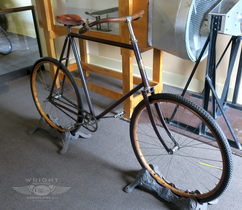
When the curators brought it down for us, the first thing we noticed
is how tall the machine is. To start this bike, you have to mount it
at a run. To stop it, you must dismount while it's still moving. There's no way a person could straddle
the bike at rest unless he/she had very long legs.
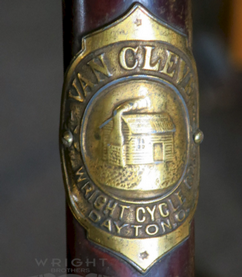
The badge is hot-stamped in brass and screwed to the head tube. The
log cabin was meant to remind Daytonians of their pioneer past.
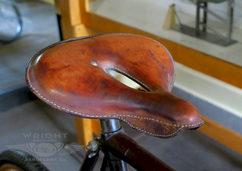
The saddle was made of leather and stuffed with horsehair.
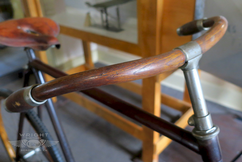
The handlebars were made of ash wood, which helped absorb the
vibration from the rough roads. It's interesting to note that the Wright
made all the bent wood parts of their airplanes from ash.
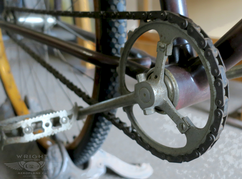
The Van Cleve has a unique two-piece crankset. Most cranksets at
that time consisted of three pieces -- two crank arms that attached
to an axle. On this set, the left crank arm and the axle are cast
and machined as a single piece. Additionally, the chain sprocket
attaches directly to the right crank arm rather than the axle, as
with other designs. This arrangement was much stronger and less
likely to wear than the common three-piece cranksets.
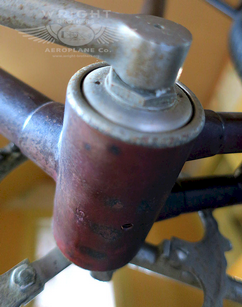
The underside of the bottom bracket is stamped "45." This may be a
manufacturer's mark to indicate the frame size, or it may be a
Wright serial number.
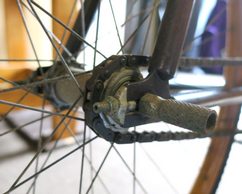
The rear hub and chain tensioner. The mounting peg (attached to the
right end of the axle) aided the rider in mounting and dismounting the
tall bike. Mounting pegs were usually attached on
the left. It was customary to mount a tall bike from the left, the
same as you would a horse.
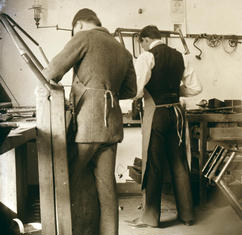
Orville and employee Ed Sines working in the Wright Cycle Co. in September of
1897. The frame that Orv is working on is the same as was used to
make the Van Cleve at Greenfield Village. The wooden handlebars hanging on the back
wall are the same as well.
|